20,000 Watt Home Hi-Fi System
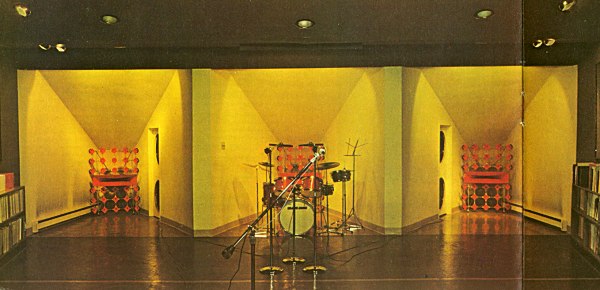

Excerpted from Audio magazine, April, 1976. pp. 44-56. By Richard S. Burwen.
This equipment has taken about 12 man-years to design and build, starting as far back as 1962. My objective is to produce the maximum entertainment value from prerecorded program sources and from live recordings. The room and equipment are designed for reproduction over five speaker systems at the original live sound levels and with more than 100 db dynamic range.
Each of the five speaker horns is 13 ft. deep and has about 64 sq. ft. of mouth area. [i.e. 8 foot x 8 foot] The horns are conical, in preference to exponential, in order to produce a gradual low frequency rolloff, instead of a sharp cutoff. As it turned out, due to reinforcement from the room, the average low frequency response on one third octave bands is flat down to 16 Hz without equalization.
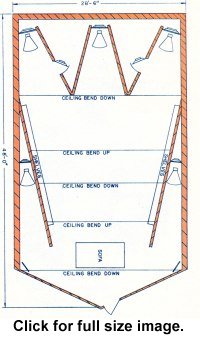
Each speaker horn contains 30 Cerwin-Vega tweeters, a midrange horn with two JBL 2440 drivers, and two Empire 16 in. woofers. In addition, the left-front and right-front horns have two 24 in. Cerwin-Vega woofers, mounted on the doors. These woofers are equipped with feedback windings to linearize their acoustic output over their range.
The rear speakers, which are shown diagrammatically in the room plan, point towards the rear of the room so as to provide reflected sound....the storerooms between the front speakers constitute a 200-cu. ft. back enclosure. The rear speakers vent into the room at the ceiling level in the manner of a bass-reflex speaker....
The entire room is solidly constructed of concrete, cinder clock and extra heavy plaster. Although the horn walls are made of 4-in. filled cinder block, I am amazed at how much these can vibrate. If I were to build a room like this again, I would use 8-in. thick walls.
The ceiling is wavy so as to diffuse the sound and the low points of the ceiling conceal heavy steel beams which support the house above.
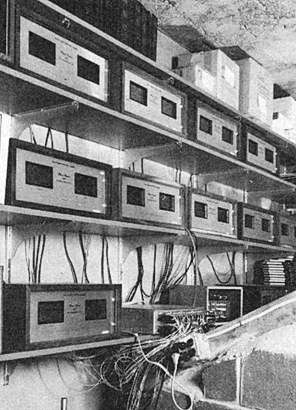 To drive these speakers there are a total of 17 Phase Linear 400 amplifiers [200 watts RMS/channel @ 8 ohms].... Each woofer, midrange horn, and set of 9 or 12 tweeters is driven from one 200 watt amplifier channel. With the electronic crossover at 50, 400 and 5,000 Hz ahead of the amplifier, the speakers can produce the same sound level that would be produced by a single 20,000 watt amplifier.... The crossover filters utilize UM201 modules to produce 6-, 12-, 18-, and 30-db/octave cutoffs for the various drivers. In addition, the crossover provides equalization to lat acoustic response.
To drive these speakers there are a total of 17 Phase Linear 400 amplifiers [200 watts RMS/channel @ 8 ohms].... Each woofer, midrange horn, and set of 9 or 12 tweeters is driven from one 200 watt amplifier channel. With the electronic crossover at 50, 400 and 5,000 Hz ahead of the amplifier, the speakers can produce the same sound level that would be produced by a single 20,000 watt amplifier.... The crossover filters utilize UM201 modules to produce 6-, 12-, 18-, and 30-db/octave cutoffs for the various drivers. In addition, the crossover provides equalization to lat acoustic response.
In designing and adjusting the crossover network, I used one-third octave noise measurements based on a six microphone average of omni-directional microphones for low frequencies and an average of two cardiods located in from of the left-front and right-front horns for high frequencies. The microphones used for adjusting the crossover frequency response are the same ones used for making recordings here, so the entire system is flat. On one-third octave noise bands, it measured flat within 1 1/2 db from 15 HZ to 20 KHz. Nevertheless, I find that when reproducing much of the prerecorded program material availible I use from 3 to 30 db of low frequency boost
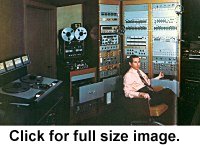
When you have a high powered sound system like this, one of the difficult problems to solve is to keep from blowing out 169 speakers at once. That is the reason for having so many speakers in the first place. The tweeters are wired three in series so that each can receive only 1/3 of the amplifier output voltage. All the speakers can handle the clipping levels of their respective amplifiers without mechanical damage. Nevertheless, during sustained clipping the voice coils can get too hot. To prevent overheating, there is an elaborate speaker protection system in each of the rear horns and one for the three front horns. The protection system has a total of 34 channels, each of which measures the amplifier power output, computes the voice coil temperture and disconnects its speaker with a relay before the voice coil gets too hot. The same system eliminates turn-on and turn-off thumps. In over a year of operation there has been no damage to any of the speakers.
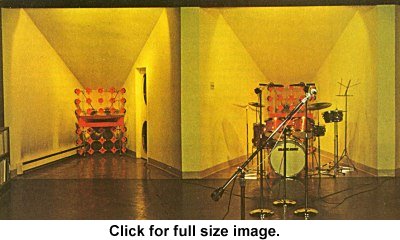
You may wonder why it takes so much power to feed such efficient speakers. I have found when reproducing a live drum set out of any one of my five horns at the original sound level, the peaks can reach within 3 to 6 db of the clipping level when the drummer is playing as loud as he can. For prerecorded music, however much less power is needed because the high peaks are clipped off during the recording process.
-Richard S. Burwen.
Back to Wayne's Speaker Building Page.